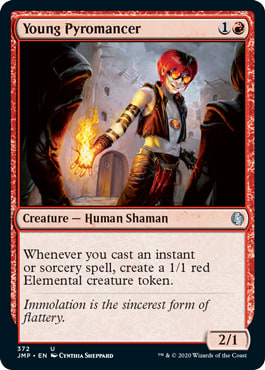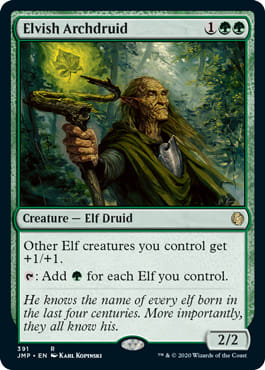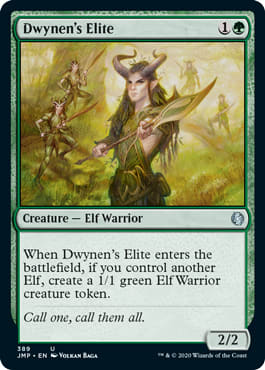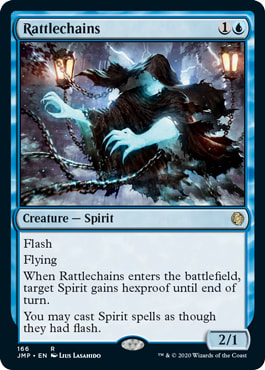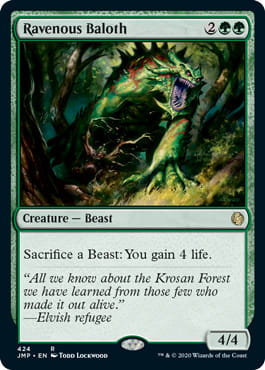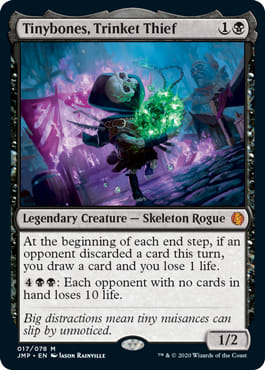Jumpstart is a brand new set that just released both in paper and on MTG Arena, filled with mostly reprints and a few new cards. It's meant to be a pseudo-sealed format, where you mix together themed packs and play right out of the box. For full info check out the official introduction page.
However, we're not really interested in the Limited or reprint aspect of Jumpstart. The most intriguing part is that it is introducing a large amount of cards not currently available on MTG Arena to the fledging Historic format. As such, today I am going to quickly go over a bundle of Jumpstart cards that you need to keep an eye on when you are building your Historic decks. Not every card is going to be a total game changer or spawn entire new archetypes, but these are all proven tournament cards that have seen major play at various points in Magic's history.
Let's dive right in!
The Thragdaddy returns!
Thragtusk is the ultimate "fair" card. It's huge, helps to stabilize any board, is durable and hard to answer, while also being easy to cast. And that's to say nothing of being able to abuse its enters and leaves the battlefield effects. Restoration Angel may not be in Historic, but Unburial Rites and other flicker effects are.
Thragtusk is good enough to see play in Modern, but is specifically good against decks looking to play fair Magic. Combo decks and decks with plans that are bigger than Thragtusk like ramping into Ulamog, the Ceaseless Hunger, Ugin, the Spirit Dragon, or Field of the Dead will laugh at you for putting a five mana, sorcery speed, non-interactive card in your deck. However, if your opponent is trying to play removal spells and planeswalkers, they are going to be in a world of hurt.
This makes Thragtusk a rather polarizing card that will wax and wane with the reality of the format, but there's no doubt that there will be times that Thragtusk is a very good thing to be doing.
The Red entry in the "really good Eternal playable two-drop" mega-cycle (alongside Stoneforge Mystic, Snapcaster Mage, Dark Confidant, and Tarmogoyf), Young Pyromancer has seen play in every single format it has been legal in, and Historic is unlikely to buck this trend.
While there's no doubting the raw power of Young Pyromancer, the question mark in Historic is how good are the spells around it? Historic doesn't have Serum Visions, Lightning Bolt, Thoughtseize, or Path to Exile, much less Brainstorm, Daze, or Cabal Threapy, meaning that finding the right critical mass of cheap and powerful spells is going to be much more difficult. Still, it doesn't take much to get excellent value out of Young Pyromancer. Even if Young Pyromancer starts out as a sideboard juke, its power level will only grow as the format grows and more cheap spells are added.
When Isamaru, Hound of Konda was printed, it was a landmark moment in Magic's history. They printed a card that was better than Savannah Lions? Inconceivable! However, we've come a long way from the days of Savannah Lions and Jackal Pup being the best aggressive one-drops ever printed.
Isamaru doesn't tip the scales on raw power level any more, but is still an interesting addition to Historic for one reason: Mox Amber. Not the most powerful Moxen ever printed, any Mox still needs to be examined closely. Isamaru is an ideal 1-drop to help turn Mox Amber on as early as turn one and that might just be good enough.
They've also errataed Isamaru's creature type to dog, which may have relevant tribal implications in the future if they flesh the tribe out more.
Speaking of tribal themes, Jumpstart has a few of them which offer powerful reprints and a few new surprises.
Goblin Chieftain enters a crowded 3-drop slot for a potential Historic Goblins deck, providing a more traditional lord effect into a deck often more interested in card advantage. Still, Goblin Chieftain certainly does up the clock in a format that lacks Goblin Piledriver.
However, the real prize for goblins is the absurd Muxus, Goblin Chieftain. Oh boy what a card! Six mana is a lot, but Muxus provides the effect of Goblin Ringleader, Goblin Lackey, and Goblin Piledriver all at the same time. When combined with the haste effect from Goblin Warchief or Goblin Chieftain, a resolved Muxus is going to end a lot of games on the spot. The concern is that Historic doesn't have Cavern of Souls, which is what makes Muxus so crazy in Legacy.
Muxus might look like a commander card, but it is the real deal. Also, if I ever build a commander deck, you can bet Muxus will be the first place I look.
Elves also get a nice boost from Jumpstart, with the powerful Elvish Archdruid joining Elvish Clancaller as well as the elvish version of Mogg War Marshall in Dwynen's Elite. Allosaurus Shepherd also joins the party as an endgame mana sink, but looks more relevant in formats that contain Chalice of the Void.
Elves is a fringe deck in Modern thanks to the power of these cards in conjunction with Heritage Druid, but while Historic may not have that powerful mana engine it does have Llanowar Elves and a smattering of other solid elves. Adding Cratorhoof Behemoth as a possible finisher and you've got a dark horse Historic deck that will improve as new elves are printed or added to the card pool.
Rounding out the interesting tribal cards are Modern playable spirits Rattlechains and Kira, Great Glass-Spinner. Rattlechains can help play into the flash elements that spirits can bring to the table, but will certainly miss flying alongside Spell Queller.
Kira is another interesting option that is very polarizing. As a legendary Wind Drake, she isn't exactly winning any races or taking up a bunch of slots in your deck, but against any deck relying on spot removal she is going to be a phenomenal tool. Kira is probably more of a niche sideboard card, but a very good one at that. It's unfortunate to note that Kira and Rattlechains don't work very well together, as Kira needs to be in play when your creature is targeted initially to trigger, you can't flash her in in response.
There was a time when Ravenous Baloth not only ruled Standard, but was a major player in Extended as well. Those were the days! Now Ravenous Baloth would be nothing more than a decent uncommon in Limited. Still, it's fun to reminisce!
Chromatic Sphere (and Chromatic Star) are cards that look so simple and innocent. They don't really do much, providing you a little bit of one shot mana fixing for a small cost. But the reality is that they're so much more than the sum of their parts.
If there's any sort of artifact or critical mass-based combo deck in Historic, I wouldn't be surprised to see Chromatic Sphere front and center. I'm actually a bit perplexed that the much more simply templated Chromatic Star wasn't the reprint of choice, but Chromatic Star is mechanically more powerful in a lot of ways as you can sacrifice it to other effects to draw as well.
It could be something as simple as drawing a card every turn with Emry, Lurker of the Loch, but I wouldn't be surprised if Chromatic Sphere is eventually used to more nefarious ends in the near future.
One of my favorite cards of all time, Oracle of Mul Daya is an amazing velocity, ramp, and card advantage tool for land heavy decks. With Field of the Dead being a major player in the format and ramping and playing extra lands a huge deal in Constructed, I'd be surprised if Oracle of Mul Daya saw no play. It can be fragile, but the effect is undeniably powerful.
Lands that tap for two mana are a relic of Magic's distant past, usually relegated to the oldest of formats like Legacy and Vintage. Phyrexian Tower isn't exactly Ancient Tomb or City of Traitors, but it's still a very powerful Magic card that is also an awesome sacrifice outlet.
What deck wants Phyrexian Tower? Truthfully, I'm not exactly sure, but sacrificing a Yarok's Fenlurker to cast Phrexian Obliterator on turn three sounds awful nice. It would also fit very nicely alongside many of the Rakdos Sacrifice decks we see in Standard, providing yet another sacrifice outlet as well as a bit more speed. Imagine turning your opponent's creature into a Dark Ritual with Claim the Firstborn? That sounds nice.
When you add "free sacrifice outlet" together with "land that taps for 2 mana" you've got a recipe for a really strong Magic card.
Grim Lavamancer is another card that has seen a ton of play across various formats over Magic's history, but unfortunately will suffer without access to the fetchlands. Without fetchlands Grim Lavamancer is going to be much more difficult to activate early, but it is a wizard which can make it appealing as part of a wizard package with Wizard's Lightning and friends as well as just being a good burn card.
It's probably not a card you can play a ton of, but even without fetchlands Grim Lavamancer still has legs.
A classic old card, I'm just here to remind you that the Zombie Infestation plus Treasure Hunt and 54 lands is now legal in Historic.
Do with that information what you will.
Thirst for Knowledge is an incredibly powerful card draw spell that often has a difficult time finding a home. The requirements are steep because you always want to discard an artifact, but decks that go that hard on artifacts are usually more linear and want something with more raw power than just a non-artifact good card draw spell.
However, there's no denying the rate here as well as the efficacy with Thirst for Knowledge can get artifacts in the graveyard if that's where you want them there. With cards like Emry, Lurker of the Loch already available as well as cards like Metallic Rebuke eventually going to make their way into the format, Thirst for Knowledge is definitely a card to watch.
Not every card is a Thragtusk, but this pair of cheap removal spells both have their uses and have seen play in Constructed before. Arclight Phoenix is a legal Magic card in Historic, and Lightning Axe has seen a ton of play with both Arclight Phoenix as well as more traditional Dredge builds in Modern for a long time. If you want to get cards in your graveyard quickly and easily while slowing your opponent's creatures down, Lightning Axe is a superb tool.
Pillar of Flame is a little less exciting as we already have Magma Spray, but being able to go to the face when necessary could be well worth the utility if you need the flexibility of also being able to exile troublesome creatures. The competition here is Shock, not Lightning Bolt like in Modern so there's a good chance Pillar of Flame sees some play.
Our last card of the day is a new one, the very interesting Tinybones, Trinket Thief.
Typically, cards that trigger on discard exist in a really awkward place where they are hard to play before the discard and the payoff really isn't there. Megrim, Waste Not... they just end up not doing enough. However, Tinybones is a Dark Confidant-style card draw engine that also has a big mana sink win condition built in as well. The 1/2 body isn't that impressive, but this could be a cute payoff for some sort of discard deck.
It's unfortunate that Tinybones won't be legal in Modern, as that is likely the place it would have played best.
Jump Right In
Jumpstart is definitely an unprecedented release for Magic that was not without its hiccups. The marketing for the set wasn't super clear, while it's also extremely awkward that there are different cards in the paper version and for the MTG Arena version. However, it seems like a real hit when it comes to being a fun tool for new players to jump right into a game but still have the thematic feel of Constructed.
Historic is certainly become quite the melting pot of different sources of cards and it will be very interesting to see where Jumpstart takes the format!

















